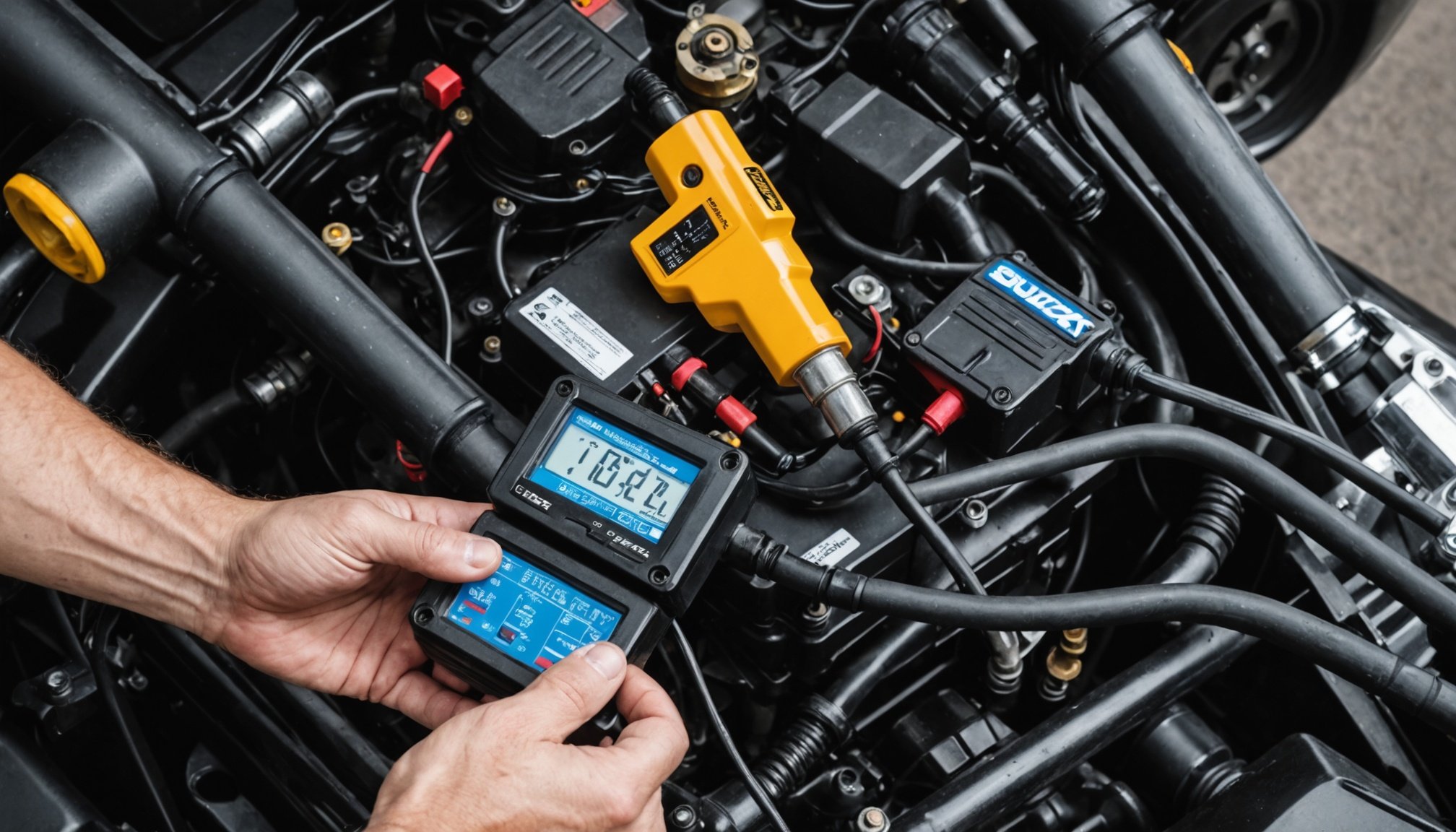Testing the ignition coil of your Suzuki GSX-R750 is essential for optimal performance. A malfunctioning ignition coil can hinder engine efficiency and impact your riding experience. This step-by-step guide offers clear instructions for using a multimeter to check your ignition coil's health. With practical tips and troubleshooting advice, riders can confidently tackle this task, ensuring their bike runs smoothly. Let's get started and empower yourself to maintain the heart of your motorcycle!
Overview of Ignition Coil Functionality
The ignition coil is a crucial component in the Suzuki GSX-R750 that significantly impacts engine performance. Its primary role is to convert the battery's low voltage into the thousands of volts needed to create a spark in the spark plugs. This spark ignites the fuel-air mixture in the engine's cylinders, facilitating combustion and powering the motorcycle.
Also to discover : Mastering Fuel Injector Issues: A Step-by-Step Guide to Diagnosing and Resolving Problems on Your BMW S1000XR
When an ignition coil is faulty, it can lead to several engine issues. Common problems include misfiring, reduced fuel efficiency, and difficulty starting the engine. Misfiring occurs when the spark is insufficient or mistimed, causing incomplete combustion. This not only affects performance but can also lead to long-term engine damage if not addressed.
Testing the ignition coil is essential for maintaining optimal engine performance. Regular checks can preemptively identify issues, ensuring the Suzuki GSX-R750 runs smoothly. Testing involves measuring the coil's resistance and checking for any signs of wear or damage. By ensuring the ignition coil is functioning correctly, riders can enjoy a reliable and efficient riding experience, free from unexpected breakdowns. Addressing ignition coil issues promptly can enhance overall engine performance and longevity.
Also to read : Essential Tips for Effectively Maintaining the Belt Drive of Your Harley-Davidson Sportster 1200
Required Tools for Testing
Before diving into the testing process, it's crucial to gather the right testing tools. For the Suzuki GSX-R750, the most essential tool is a multimeter. This device measures electrical properties such as voltage, current, and resistance, which are vital for diagnosing the ignition coil's health.
When using a multimeter, understanding its settings is key. For ignition coil testing, focus on the resistance measurement setting. Ensure that the multimeter is set to the correct range to obtain accurate readings. There are different types of multimeters, including analog and digital. Digital multimeters are generally preferred for their precision and ease of use.
In addition to a multimeter, consider other safety gear and precautions. Always wear insulated gloves when working with electrical components to prevent shocks. Safety goggles are also advisable to protect your eyes from any unexpected sparks or debris. Ensure the motorcycle is turned off and the battery is disconnected before starting any tests to avoid accidental ignition.
By equipping yourself with the right tools and taking necessary precautions, you can effectively test the ignition coil, ensuring your Suzuki GSX-R750 remains in peak condition.
Preparing for the Test
Before testing the ignition coil in your Suzuki GSX-R750, proper testing preparation is crucial to ensure safety and accuracy. Begin by safely accessing the ignition coil. This often involves removing the motorcycle's seat and any protective panels that cover the engine components. Refer to your motorcycle's manual for specific instructions and diagrams to locate the ignition coil accurately.
Disconnecting the battery is an essential safety step. This prevents accidental ignition or electrical shock during the testing process. Ensure the negative terminal is disconnected first to minimize risks. This step is non-negotiable for safe testing preparation.
Once the battery is disconnected, visually inspect the ignition coil and surrounding components. Look for any obvious signs of wear, corrosion, or damage. A visual inspection can sometimes reveal issues that may not require testing equipment to diagnose.
Having visual aids or diagrams is beneficial. They can guide you through the process of locating and accessing the ignition coil. Many manuals provide these, but online resources can also be helpful. Following these steps ensures a secure and effective testing environment, allowing for precise diagnostics of the ignition coil's condition.
Testing Resistance with a Multimeter
To ensure the ignition coil on your Suzuki GSX-R750 is functioning properly, conducting a multimeter testing for resistance is essential. This process can identify potential faults and confirm the coil's health.
Step-by-Step Instructions for Resistance Testing
-
Set Up the Multimeter: Begin by setting your multimeter to the resistance (ohms) setting. Ensure it's calibrated correctly for precise readings.
-
Connect the Multimeter: Attach the multimeter probes to the ignition coil terminals. The red probe should connect to the positive terminal, while the black probe connects to the negative terminal.
-
Record the Reading: Observe the multimeter display for the resistance value. For the Suzuki GSX-R750, the ideal resistance should fall within the manufacturer's specified range.
Ideal Resistance Values
A functioning ignition coil typically exhibits a resistance between 0.5 to 3 ohms for the primary coil and 10,000 to 15,000 ohms for the secondary coil. Deviations from these values may indicate a faulty coil.
Interpreting Multimeter Readings
If your readings fall outside the ideal range, it may suggest issues such as a short circuit or coil degradation. Common faults include high resistance, indicating poor conductivity, or low resistance, suggesting potential shorts. Identifying these faults early can prevent further engine complications.
Testing Voltage Output
Testing the voltage output of the ignition coil on your Suzuki GSX-R750 is crucial for diagnosing performance issues. This procedure ensures that the coil is delivering the necessary voltage to ignite the fuel-air mixture effectively.
Procedure for Voltage Testing
To begin, connect a voltmeter to the ignition coil. Attach the positive probe to the coil's output terminal and the negative probe to a ground point on the engine. Start the engine and observe the voltmeter reading. The expected voltage output should be significantly higher than the battery voltage, typically around 20,000 volts or more. This high voltage is essential for creating a strong spark in the spark plugs.
Importance of Timing and Signal
During voltage testing, timing and signal consistency are vital. The ignition coil must deliver voltage at precise intervals to ensure optimal engine performance. Any delay or inconsistency can lead to misfiring or reduced power output.
Identifying Voltage Issues
If the voltage output is below the expected range, it may indicate a failing coil or issues in the ignition system. Low voltage can cause weak sparks, leading to inefficient combustion. Identifying and addressing these voltage issues promptly can prevent further engine damage and maintain the motorcycle's performance.
Troubleshooting Common Issues
When it comes to troubleshooting ignition coil problems in your Suzuki GSX-R750, identifying symptoms early can prevent more significant issues. Common signs of a faulty ignition coil include engine misfires, reduced power, and difficulty starting. These symptoms often arise from insufficient spark generation, leading to incomplete combustion.
Identifying Symptoms of a Faulty Ignition Coil
- Engine Misfires: This occurs when the coil fails to deliver a consistent spark, disrupting the combustion process.
- Reduced Power: A weakened coil may not generate enough voltage, leading to sluggish acceleration.
- Difficulty Starting: If the coil can't provide the necessary spark, the engine may struggle to start or not start at all.
Solutions for Addressing Common Ignition Coil Failures
Routine maintenance can mitigate many ignition coil problems. Regularly inspect and clean the coil and its connections to prevent wear-related issues. If problems persist, replacing the coil may be necessary to restore optimal performance.
When to Seek Professional Assistance
If troubleshooting efforts don't resolve the issues, or if you're uncertain about handling electrical components, it's wise to consult a professional. They can provide a more thorough diagnosis and ensure your Suzuki GSX-R750 operates safely and efficiently.
Maintenance Tips for Ignition Coils
Proper ignition coil maintenance is essential for ensuring the engine longevity of your Suzuki GSX-R750. Regular upkeep can prevent unexpected failures and maintain optimal performance.
Recommended Maintenance Practices
- Routine Inspection: Regularly check the ignition coil and its connections for signs of wear or corrosion. Clean any debris or buildup that could affect performance.
- Resistance Testing: Periodically test the coil's resistance using a multimeter to ensure it remains within the manufacturer's specified range. This helps detect early signs of degradation.
- Secure Connections: Ensure all electrical connections are tight and secure. Loose connections can lead to poor conductivity and performance issues.
Signs Indicating Replacement
- Persistent Misfires: If misfires continue despite maintenance, the coil may need replacing.
- Visible Damage: Cracks or burns on the coil surface are clear indicators of potential failure.
- Consistent Difficulty Starting: Regular starting issues suggest the coil isn't providing adequate spark.
Preventative Measures for Longevity
- Avoid Overheating: Ensure the engine cooling system is functioning correctly to prevent coil overheating.
- Use Quality Parts: Always opt for high-quality replacement parts to ensure compatibility and durability.
- Regular Maintenance Schedule: Adhering to a consistent maintenance routine can significantly extend the life of the ignition coil.











